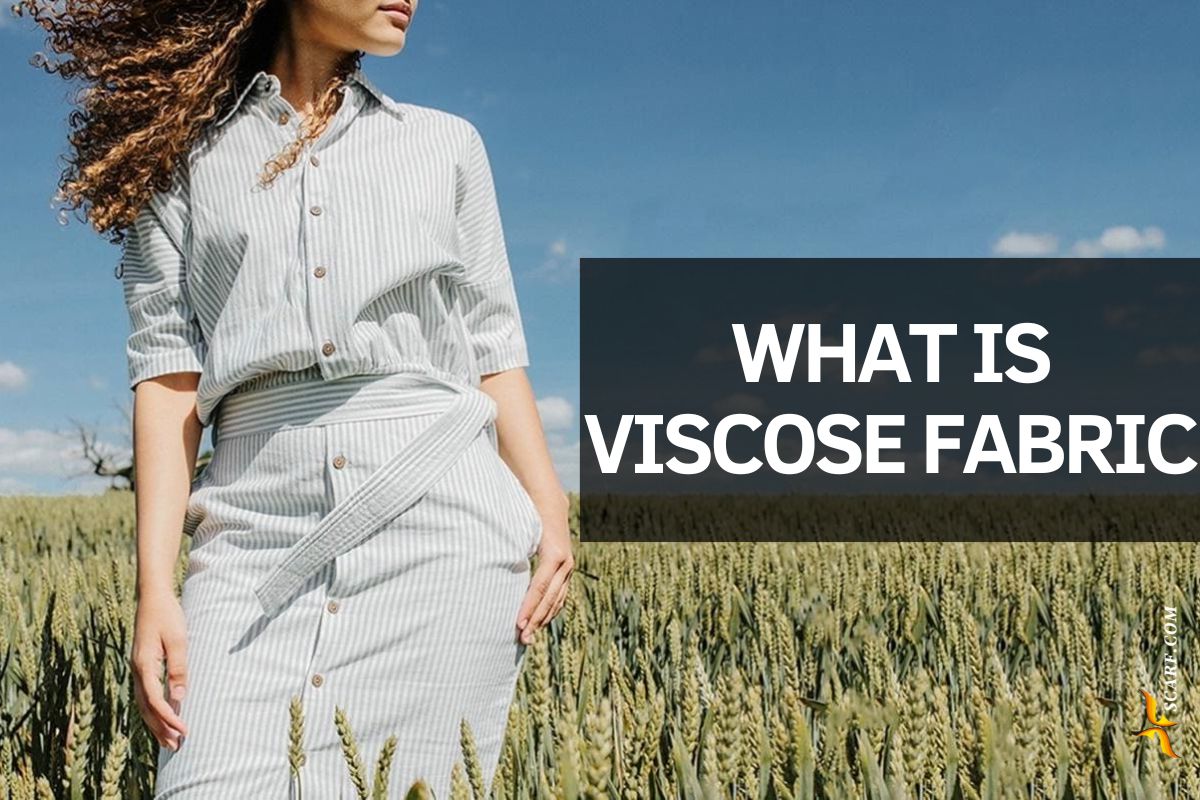Do you know your shirts are made of viscose fabric? Viscose is one of the most popular raw materials in the textile industry. It is as soft as silk, but much cheaper, easy to make. But does viscose shrink? Is viscose stretchy?
Whether you’re a fashionista, designer, or just curious about the inner workings of viscose, this article will walk you through all the basics of viscose fabric.
What is viscose fabric?
The semi-synthetic rayon fabric, Viscose, is very popular. It is made from wood pulp such as that of beech, eucalyptus hemlock and spruce.
How is Viscose made?
The fibers used to make viscose are made of natural cellulose fibres, which have been chemically treated and processed in order to change their properties and characteristics. The steps in the production of viscose fibres are as follows:
Viscose can be made primarily from wood pulp, or other plants rich in cellulose like sugarcane. The raw material of choice is harvested and then processed to extract cellulose. Wood pulp, for example, is treated chemically to remove impurities and breakdown the fibers.
The cellulose processed is then dissolved into a chemical solution, usually a mixture of sodium hydroxide with carbon disulfide. This mixture produces a viscous solution with a thick syrup-like consistency. The solution is monitored and adjusted until it reaches the desired chemical composition.
The solution is then poured through tiny holes, called ”spinnerets”, to produce thin, continuous filaments. The filaments are then immersed in sulfuric acid, which solidifies the cellulose and turns it into a solid. To remove all remaining chemicals, the filaments are cleaned, neutralized and dried.
The solidified filaments can be spun into yarns using various spinning techniques such as open-end or ring spinning. The yarns produced can be spun to different textures and thicknesses, depending on the end product.
The yarn is then woven into the fabric by using traditional textile production methods. Fabrics can also be treated to change their properties, like softness.
The viscose fibres can be further processed, including dyeing, printing or finishing, to improve their appearance.
Does Viscose Shrink?
It can. Viscose, a rayon-based fabric, is used widely in the apparel industry. The fabric is excellent at holding colours, but it’s very sensitive to moisture. The viscose fabric is weakened when it gets wet. This leads to the breakdown of fibres in the garment. Viscose can shrink and lose its colour when it dries.
Tips: Is Polyester Stretchy & Waterproof? What is Polyester Fabric?
If you are wondering whether viscose can be biodegraded and how to prevent shrinking fabric, then this article is for you. If washed with hot water and dried by machine, 100% viscose fabric can shrink up to 25% after the first wash. However, 3-5% is more common.
The viscosity percentage in a blend
If the fabricator pre-shrank the material
Original quality of viscose fabric
It depends on how carefully you follow the recommended gentle washing practices.
What are the properties of viscose fabric?
The fabric is popular among consumers because of its many properties. Here are a few of its most notable properties:
Softness
The texture of the fabric is similar to that of natural silk. This makes it extremely comfortable to wear. Viscose fabric is hypoallergenic, making it a great choice for skin that’s sensitive.
Breathability
Viscose fabric is highly breathable and allows air to freely circulate through its fibers. This allows heat and moisture escaping, keeping wearers cool and comfortable in hot regions. Viscose makes a great choice for activewear and summer clothing.
Absorbency
The fabric is highly absorbent, and can absorb and repel moisture. This helps to keep the wearer comfortable and dry, even when performing strenuous physical activities or during scorching summer days. This property is also used in printing and dyeing, which allows for vibrant colors.
Lightweight
The fabric drapes beautifully and gracefully when draped on the body. The fabric’s flowing nature enhances the natural contours of the body, resulting in an elegant silhouette. Viscose fabric is lightweight, which makes it easy to pack when travelling.
Versatile
Viscose has a wide range of uses. Viscose can be made into lightweight fabrics that are breathable for summer or heavier clothing for the colder months. It blends well with spandex and other fabrics that enhance its properties.
Is viscose stretchy?
It does not have the same level of elasticity as materials such as elastane and lycra. Spandex can stretch up to 400% of its size, viscose can only stretch up to 2%. It is possible to blend viscose with other materials in order to increase its stretch.
The lack of stretch in viscose doesn’t diminish its appeal. Fashionistas love its ability to move and drape fluidly. It’s especially popular for wide-leg pants, flowing dresses and blouses.
How to wash viscose fabric?
To treat stains, treat the affected area with a stain-remover designed for delicates. This is a product that treats stains caused by oil and food stains. Use a stain remover brush and cool water to work the stain treatment into the fabric.
Tips: Wash a hat in the dishwasher – Step-by-Step
Hand Wash
It is best to wash viscose by hand with cold water, a gentle detergent and delicate soap. Do not soak viscose longer than 30 min. Instead of wringing out the water, rinse and gently press it out. Then air dry.
Machine Wash
If you want to wash viscose, you can do so in your washing machine. However, if you choose this method, it is best to turn the item inside out and put it into a mesh bag in order not have it snag or tear.
Choose the delicate cycle in the washing machine and ensure that the water temperature is low and the spin speed is low.
The amount of delicate detergent to use depends on the size and type of machine.
Tips: How to Wash Cashmere Scarf? Hand or Machine?
Tips: How to Wash a Silk Scarf – Scarves Cleaning Guide
Dry & Finish
The item can be dried by hanging it or laying it flat and in its original shape. Don’t put it in the tumble dryer as it could shrink.
We recommend steaming to remove wrinkles for the safest and best finish.
You can still iron viscose if you don’t own a steamer. Just hover over the item while using the steam option.
What is the difference between rayon and viscose?
Although viscose is made using the same manufacturing process as rayon, there are some differences. Rayon is made from cellulose, which is derived in a number of different plants. It is highly absorbent and breathable. It is dyeable and is often used to weave skirts, shirts and gowns. Viscose comes from rayon. The cellulose is derived from wood pulp, cotton linter or cotton sinter. It is silky and lustrous, but feels like cotton. Viscose is used in many shirts, tops, scarves and blouses because of its soft, touchable texture.
Any questions about the fabric, please contact us, we have been engaged in fabric accessories for more than 10 years, help you design any patterns you like.
FAQ
Does viscose fabric shrink?
Yes, viscose fabric can shrink, especially when washed in hot water or dried at high temperatures. Viscose is a semi-synthetic material made from natural fibers, and it tends to be sensitive to heat and moisture. To minimize shrinkage, wash viscose in cold water on a gentle cycle and lay it flat or hang it to dry. Avoid using a dryer, as the heat can cause significant shrinkage. Always check the care label for specific instructions.
Viscose fabric good or bad?
Viscose fabric has both pros and cons. It is soft, breathable, lightweight, and has a silky feel, making it comfortable and versatile for various garments. However, viscose is prone to wrinkling, shrinking, and losing strength when wet, requiring careful handling and special care when washing. It is also less durable than some other fabrics and can pill over time. Overall, viscose is good for its comfort and drape but may not be ideal for all uses due to its care requirements.
Viscose fabric is stretchy?
Viscose fabric itself is not naturally stretchy. It is a semi-synthetic fiber made from wood pulp and does not have elastic properties. However, it can have a slight natural stretch due to its weave. To achieve more stretch, viscose is often blended with other elastic fibers like spandex or elastane.
Is viscose breathable?
Yes, viscose is breathable. It is a lightweight and absorbent fabric that allows air to circulate, making it comfortable to wear in warm weather. Viscose’s breathability and ability to wick away moisture make it a popular choice for summer clothing, activewear, and other garments where comfort is a priority. However, its breathability can vary depending on the thickness and weave of the fabric.
Is viscose a natural fiber?
Viscose is not a purely natural fiber, but rather a semi-synthetic or regenerated fiber. It is made from natural materials, primarily wood pulp (often from beech, pine, or bamboo), which is chemically processed to convert the cellulose into a fiber that can be spun into fabric. While it originates from natural sources, the manufacturing process involves significant chemical treatment, distinguishing it from fully natural fibers like cotton or linen.
What is bamboo viscose fabric?
Bamboo viscose fabric is made from bamboo fibers processed into a viscose, or rayon, fabric. It is known for being soft, breathable, and eco-friendly. Bamboo viscose is often used in clothing, bed linens, and towels due to its moisture-wicking and antibacterial properties. It’s generally more sustainable than traditional viscose because bamboo grows quickly and requires fewer chemicals in processing. However, it still involves chemical treatment in its production.



